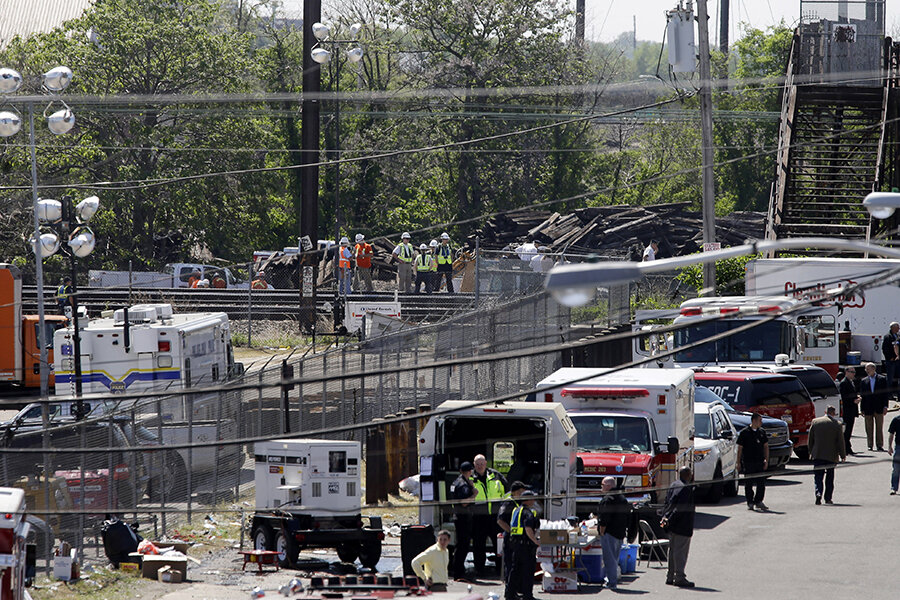Eighth victim recovered from Philadelphia train crash wreckage
Loading...
| Philadelphia
Rescuers pulled an eighth body out of the wreckage of an Amtrak train that derailed this week in Philadelphia, a city official said on Thursday, as the attorney for the engineer who was at the controls said his client had no memory of the accident.
Philadelphia Mayor Michael Nutter told a news conference that it is now believed all 243 people, including five crew, have been accounted for. The train was bound for New York City from Washington, D.C., when it crashed on Tuesday night.
Amtrak train No. 188 was barreling into a curve at more than 100 miles per hour, twice the speed limit. The National Transportation Safety Board (NTSB) said the engineer triggered the emergency brakes seconds before the derailment.
One of the seven cars flipped over, and three others were overturned. Passengers, crew and luggage were thrown from seats and overhead racks.
About 200 people were injured.
On Thursday morning, a cadaver dog found the body of a passenger in the twisted metal of the first car, Fire Commissioner Derrick Sawyer said.
"I don't think that any common sense rational person would think that it was OK to travel at that level of speed knowing there was a pretty significant restriction on how fast you should go through that turn," Nutter said, repeating an earlier comment he had directed at the engineer.
NTSB officials said they had not yet interviewed the engineer, identified as Brandon Bostian, a resident of the New York City borough of Queens, giving him time to recover from a concussion.
Nutter said the engineer had briefly spoken with investigators in the hours after the crash but that he had declined to be interviewed in depth.
Bostian was cooperating with authorities, according to his attorney Robert Goggin, but had no memory of the crash and "no explanation" for what happened.
"He remembers coming into the curve, he remembers attempting to reduce speed, but thereafter he was knocked out just like all the other passengers on the train," said Goggin during an appearance on ABC's "Good Morning America."
Bostian, who has a concussion and gash to his head, does not remember deploying the emergency brakes, the lawyer said.
"I believe as a result of the concussion, he has absolutely no recollection whatsoever of the event," Goggin said. "We will have to wait for his memory to come back or for other facts to be ascertained by the NTSB."
The office of Philadelphia District Attorney Seth Williams is deciding whether to press criminal charges against Bostian, a spokesman said.
"We are gathering information and are still in the preliminary part of fact-finding," spokesman Cameron Kline said.
NTSB investigators want to talk to Bostian "as soon as he's available," Robert Sumwalt, an NTSB board member who is serving as spokesman for the federal investigation, told Reuters.
"It's not that uncommon at all to not remember things" after such a traumatic event, he said.
Sumwalt said the derailment could have been avoided if the train had been equipped with an advanced safety system called "positive train control (PTC)," which automatically slows or halts trains moving too fast or heading into a danger zone.
By law, the rail industry must adopt the technology by the end of this year. Amtrak has begun installing components of the PTC system but the network is not yet functioning, federal officials said.
"It's tragic to investigate an accident. It's even more tragic to investigate and not to see those recommendations that we called for because we know they can prevent accidents," Sumwalt told Reuters.
Application of the emergency brakes slowed the train slightly to 102 mph from 106 mph in the seconds before the derailment, Sumwalt said.
Nutter said officials were not releasing information about the eight people who died. He said 43 people were still hospitalized.
Dr. Herbert Cushing, chief medical officer at Temple University Hospital, which is treating some of the injured, said at a media briefing that many of them were improving and likely would go home on Thursday.
Eight of the injured were in critical condition, he said.







